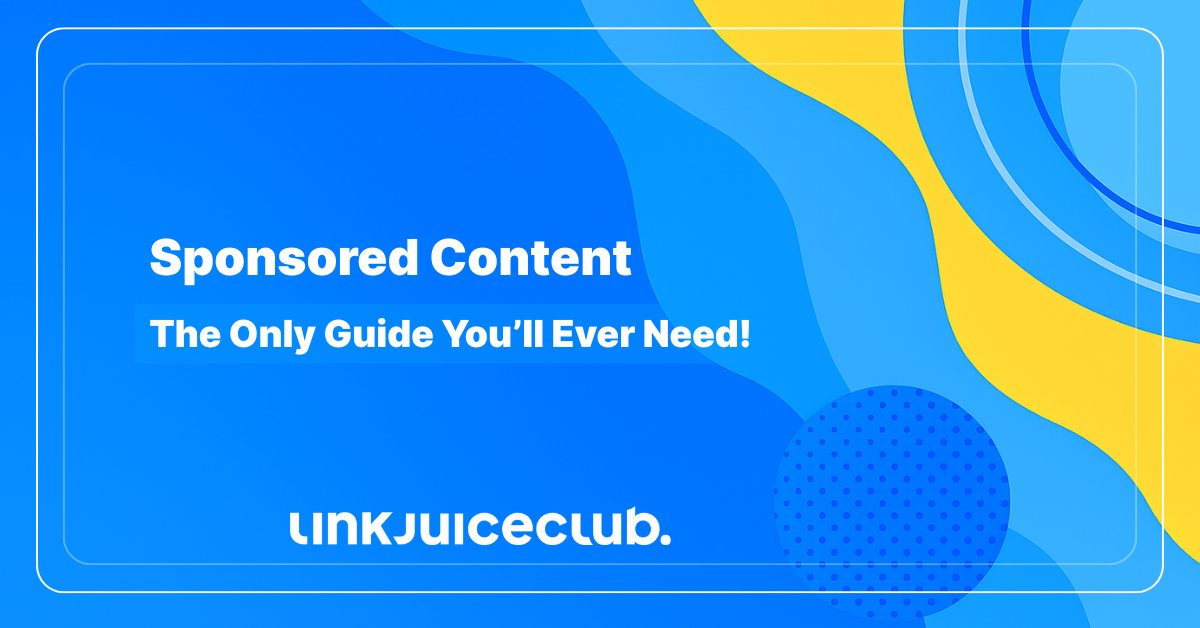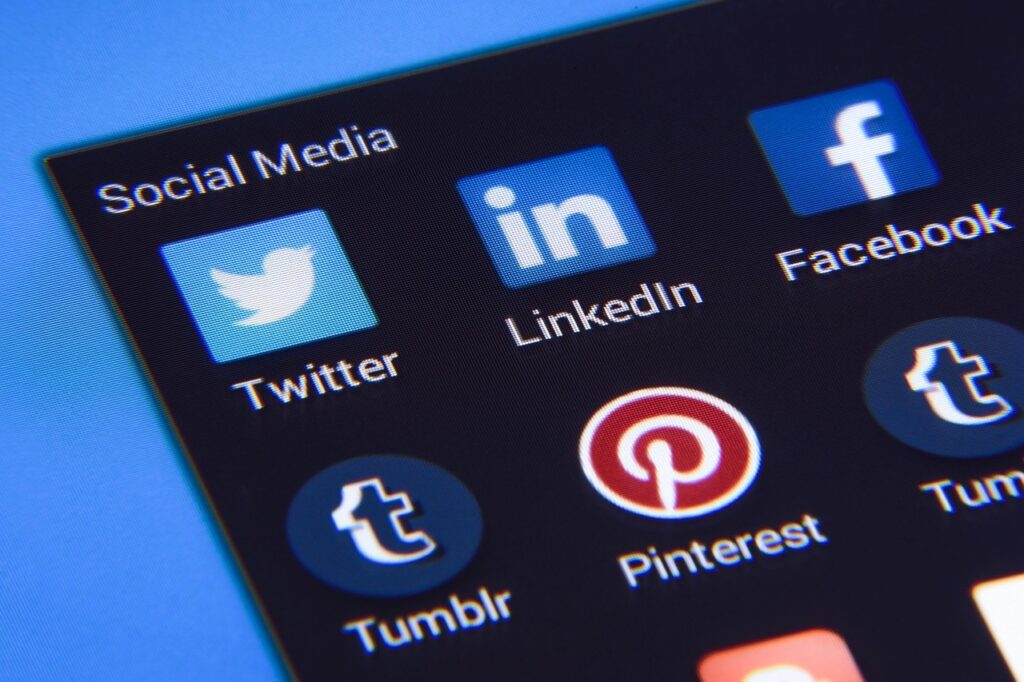
Sponsored Content: The Only Guide You’ll Ever Need!
Sponsored content is one of the smartest ways to put your brand in front of the right audience without shouting hey, this is an ad. When it’s done right, it blends in with the surrounding content, earns real attention, and drives action.
But success isn’t accidental. It takes strong storytelling, precise targeting, and a solid SEO backbone. This guide breaks down exactly how to do sponsored content right!

What Counts as Sponsored Content (and Why It’s Not Just a Fancy Ad)
Sponsored content is paid content that lives on someone else’s platform. This can be a blog post that features your product, a YouTube video with a casual brand mention, or an influencer’s Instagram Reel that just so happens to include your stuff.
The key? It doesn’t look or feel like a traditional ad. It blends in.
Sponsored content matches the tone, format, and vibe of the platform it appears on, making it feel natural, not pushy. That’s why it works.
Sponsored Content vs. Native Ads: Same Suit, Different Tie?
More often than not, sponsored content and native advertising often get tossed into the same bucket, but they’re not always identical twins. They’re more like cousins in the content marketing family!
As we said, sponsored content typically involves a brand paying a third party (like a publisher or influencer) to create and publish content that subtly promotes their product.
Native advertising, on the other hand, is usually created by the advertiser and placed on platforms where it blends in visually and contextually. Those Recommended for You widgets at the end of articles? Classic native ads. They look like site content, but clicking on them often drops you into a sales funnel.
While some marketers use the terms interchangeably, others argue over the creative ownership and publishing control. At the end of the day, both aim to do the same thing: promote without disrupting.
The Many Faces of Sponsored Content
Sponsored content doesn’t come in one-size-fits-all. It’s flexible, adaptable, and shows up in whatever format your audience is most likely to click on. Here are the most common types that actually get attention (and results!).
Video & Visuals: Scroll-Stopping Sponsored Content
From snappy Instagram Reels to full-blown YouTube deep dives, visual content is a powerful format for sponsorships. It grabs attention fast, delivers a message even faster, and doesn’t need a wall of text to be memorable. Whether it’s an infographic on LinkedIn or a cinematic brand feature on TikTok, visuals do the heavy lifting with subtle product placement and storytelling.
Sponsored Articles: Still the Gold Standard
Articles are the OG of sponsored content, and for good reason. When done right, they blend perfectly into a site’s regular editorial flow while quietly promoting a product or brand.
Unlike hard-sell ads, sponsored articles earn attention by offering insights, solutions, or entertainment first. The promotional aspect is woven in (never forced), so readers don’t feel like they’re being sold to. That’s the secret sauce: relevance over interruption.
For brands, this format opens the door to deeper storytelling and more natural backlinking. And for publishers, it means engaging content that still pays the bills. As long as the writing aligns with the tone and standards of the platform, sponsored articles continue to be one of the smartest plays in the content marketing playbook.
Podcast Sponsorships: Ads That Sound Like Recommendations
Podcasts offer a unique trust-based environment where a few words from a beloved host can move mountains.
Sponsored segments can show up before the episode starts (pre-roll), in the middle (mid-roll), or at the end (post-roll). Mid-rolls tend to have the most impact, especially when the host weaves the message into the conversation like it’s a personal recommendation.
The trick here is subtlety. Listeners trust the voice in their ears, so when a brand is introduced naturally, it feels like a tip from a friend, not a sales pitch. Most successful podcasts monetize this way, and it works across niches – from finance to true crime.
Sponsored Posts: A Win-Win for Brands and Creators
Sponsored posts are strategic partnerships that fuel growth on both sides of the content equation.
For Brands: Instant Cred (and Targeted Reach)
Why chase followers when you can borrow the loyalty someone else already built?
Sponsored posts give brands front-row access to highly engaged niche audiences, without spending years building one from scratch. It’s like getting a golden ticket to someone else’s party, where everyone’s already into what you sell.
And because the message comes from a trusted voice, it doesn’t feel like a hard sell. Audiences are far more likely to pay attention (and act) when the recommendation comes from a creator they know and trust!
For Creators: Monetize the Magic
For creators, sponsored content is more than a paycheck; it’s how they keep the lights on and the creativity flowing. Teaming up with relevant brands means getting paid and staying true to your audience. No awkward product plugs. No selling out. Just smart partnerships.
Beyond the money, brand collabs often mean early product drops, exclusive invites, and a boost in production value. This results in better content, more clout, and the kind of credibility that opens even more doors down the line.
The Dos and Don’ts of Sponsored Content (Without Screwing It Up)
Creating sponsored content that hits all the right notes is all about strategy, clarity, and knowing when to zip it and when to shout it.
These are the Dos
Experts at Link Juice Club created the following list of things that should be done when dealing with sponsored content.
✅ Choose the Right Platform (Seriously)
Don’t shoot a LinkedIn-style essay at an audience glued to TikTok. Tailor your content to where your audience lives – and more importantly, where they actually engage. Instagram Reels? Go for a visual punch. LinkedIn? Drop the data. Picking the wrong platform is like showing up to a pool party in a three-piece suit.
✅ Be Loud About Being Sponsored
No one likes being duped. Label your content clearly: #sponsored, Ad, or Paid partnership should be right there in the spotlight. Not only does this build trust (which pays off in engagement), but it also keeps you on the good side of advertising laws.
✅ Test, Tweak, Repeat
You don’t publish and ghost. Use analytics to see what’s working and what isn’t. Is the video format flopping? Are people bouncing before they click the CTA? Use the data to refine and optimize. Sponsored content should evolve, not just exist.
✅ Give People Something They Actually Want
Entertain. Educate. Inspire. Solve a problem. Give them a reason to care, and they’ll stick around. Sponsored content works best when it feels like value, not a sales pitch in disguise. If it wouldn’t interest you as a consumer, it won’t work for anyone else.
✅ Speak Their Language
Your audience are real people with specific interests, habits, and humor. Do your research. Dig into what they’re reading, watching, and talking about. The closer you hit their vibe, the more likely they are to engage (and maybe even share!).
The Don’ts: Rookie Mistakes You’ll Want to Dodge
If the dos are the golden rules, the don’ts are the red flags waving in your face. Sponsored content that backfires usually crashes because someone ignored one (or all) of these no-go zones.
❌ Don’t Try to Pull a Fast One
Disguising sponsored content as organic isn’t clever, it’s shady. Transparency builds trust. Always label your partnerships clearly. It’s good ethics and good business.
❌ Don’t Serve Half-Baked Content
Sloppy copy? Lazy design? Blurry visuals? Nope. Sponsored content should never feel like an afterthought. If anything, it should be more polished than your regular posts. Whether you’re writing it yourself or working with a team, invest the time to make it sharp, well-researched, and actually worth consuming.
❌ Don’t Turn It Into a Billboard
People didn’t come to your blog or video just to get hit with a glorified commercial. Avoid shouting about your product like it’s a clearance sale. Instead, show how it solves a problem, tell a story, or sneak it into a narrative. Subtle sells better.
❌ Don’t Ignore the Comment Section
Your audience isn’t just there to listen – they’re talking too. Read the comments. Listen to the feedback. Even the snarky ones. It’s gold for improving your next campaign and avoiding future missteps. Respond, adapt, evolve. It shows you’re human!
Scroll, Click, Convert: Where Sponsored Content Comes to Play
From the dance-happy world of TikTok to the suit-and-tie vibes of LinkedIn, each channel brings its own flavor to the table. Let’s break down how sponsored content shows up across some of the biggest players.

TikTok: The Viral Playground
TikTok is a creative chaos machine! Here, brands don’t just advertise; they join trends, create original audio, and challenge users to participate. Think branded hashtags, Duets with influencers, or hopping on viral memes while they’re still hot.
TikTok’s magic? In-app shopping features that let users go from that’s cool to it’s mine now in seconds. But keep in mind: content that feels too stiff or overly branded sticks out like a sore thumb. Authenticity wins here.
LinkedIn: The Professional Powerhouse
LinkedIn is where your buttoned-up B2B campaigns get to stretch their legs. Sponsored content here works best when it adds genuine value (for example, case studies, insider tips, or industry thought leadership).
Instagram: A Visual Goldmine
Instagram remains a sponsored content staple, especially for brands looking to strike hard with visuals. Reels dominate right now; they’re perfect for bite-sized product demos, behind-the-scenes sneak peeks, or influencer shout-outs that look native to a user’s feed.
Stories are still a secret weapon, too. Short, snappy, and clickable, they’re excellent for flash promotions or tapping into FOMO. And with built-in shopping tools, Instagram’s basically a storefront disguised as social media.
Facebook: Still a Targeting Titan
Don’t let the boomer app jokes fool you! Facebook is still very, very popular. Its strength lies in laser-sharp targeting and endless ad format options.
Sponsored posts look like regular updates, but with that extra budget boost, they can reach just about anyone, anywhere. Facebook’s a beast when it comes to reach, but you’ll need thumb-stopping content to stand out in the cluttered feed.
Ready, Set, Sponsor: Your First Steps into Paid Collaborations
Thinking of diving into the world of sponsored content but don’t know where to begin? Here’s how to build a sponsored content game plan that’s smart, strategic, and built to last.
Lock In Your Goals First
Before you post anything (or even think about partnerships) figure out what you’re trying to achieve.
Also, define your audience. Are they Gen Z sneakerheads or C-suite SaaS nerds? Knowing who you’re speaking to will shape everything else, from your tone to your platform of choice.
Pick the Right Platform (and the Right People)
Once your goals are solid, it’s time to play matchmaker. Choose platforms where your target audience actually hangs out. Don’t waste time shouting into the void of the wrong feed.
And when it comes to collaborators? Skip the vanity metrics. An influencer with 10K ride-or-die fans beats a 1M-follower ghost town any day!
Negotiate With Confidence (and Fairness)
Creators, know your worth. Your time, your creativity, and your reach all hold value. Don’t lowball yourself just to land a deal, but also don’t ghost brands by asking 5x your market rate without explanation.
Brands: Be transparent, clear, and collaborative. Set expectations early and respect the creator’s process.
Sponsored Content Done Right
Sponsored content is a strategy! A clever, adaptable, and powerful one. Whether you’re a brand trying to escape the ad-fatigue trap or a creator looking to monetize without losing your voice, sponsored posts offer a win-win when done right.
From understanding the formats and platforms, to nailing the balance between authenticity and promotion, the key lies in delivering value without shouting for attention. Be transparent, be intentional, and above all be relevant.





